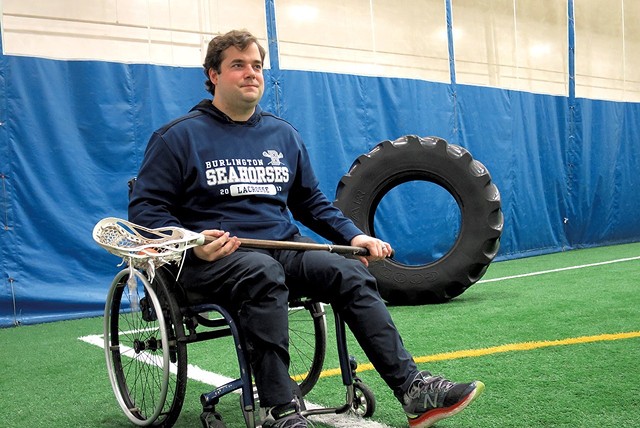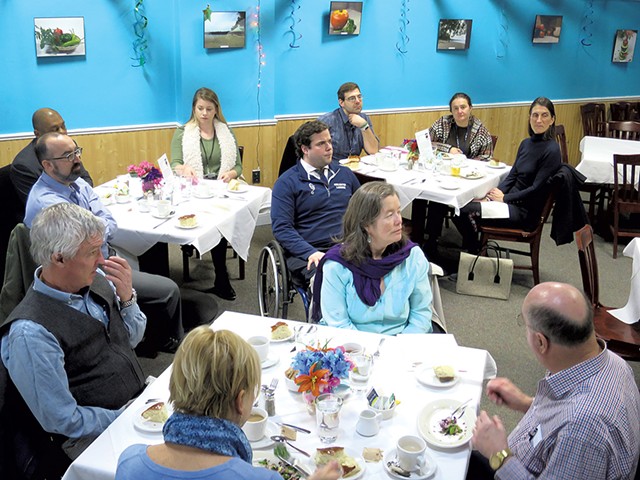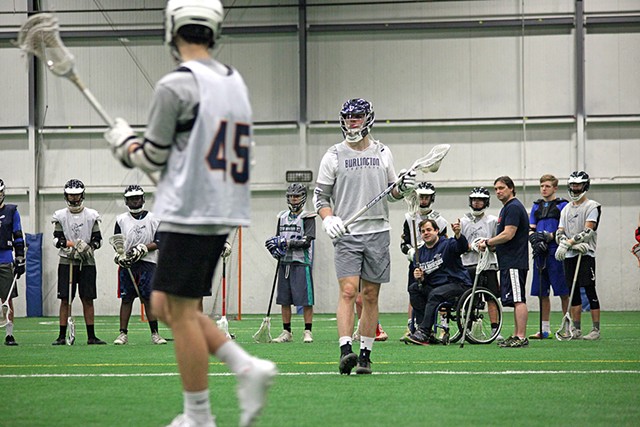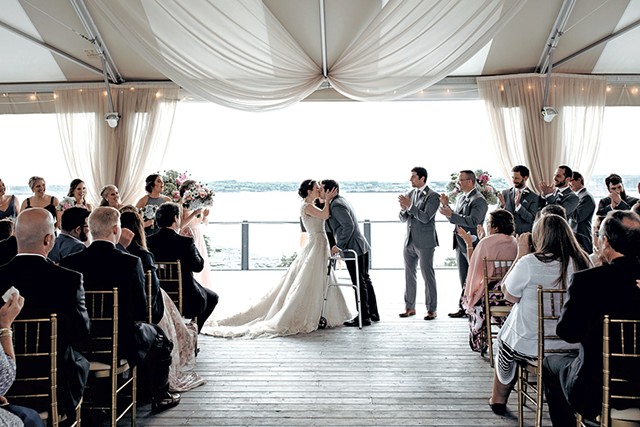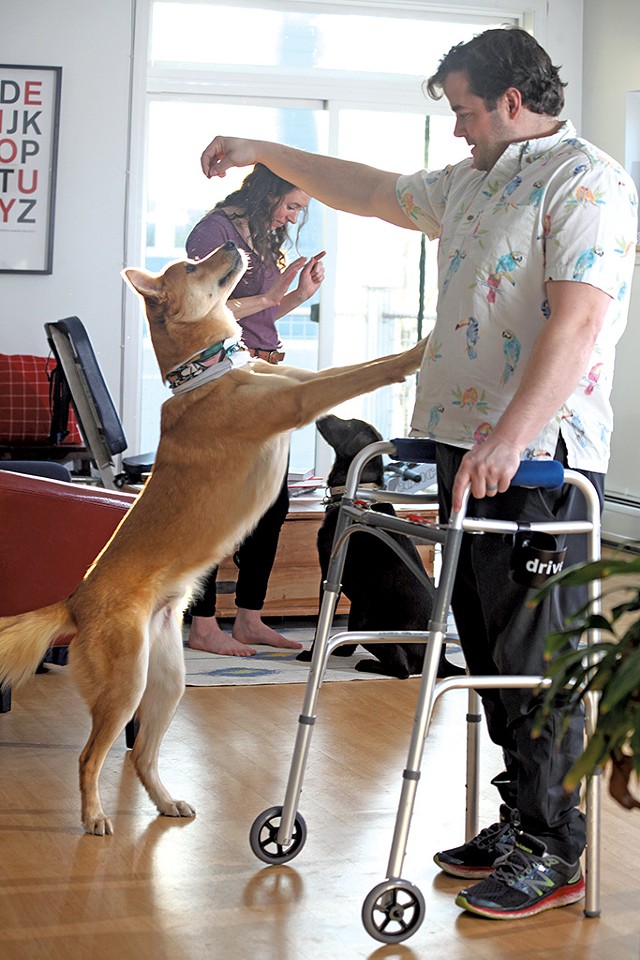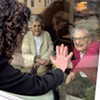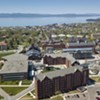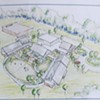Switch to the mobile version of this page.
Vermont's Independent Voice
- News
- Arts+Culture
- Home+Design
- Food
- Cannabis
- Music
- On Screen
- Events
- Jobs
- Obituaries
- Classifieds
- Personals
Browse News
Departments
Browse Arts + Culture
View All
local resources
Browse Food + Drink
View All
Browse Cannabis
View All
-
Culture

'Cannasations' Podcaster Kris Brown Aims to 'Humanize'…
-
True 802

A Burlington Cannabis Shop Plans to Host…
-
Business

Judge Tosses Burlington Cannabiz Owner's Lawsuit
-
Health + Fitness

Vermont's Cannabis Nurse Hotline Answers Health Questions…
-
Business

Waterbury Couple Buy Rare Vermont Cannabis License
Browse Music
View All
Browse On Screen
Browse Events
View All
Quick Links
Browse Classifieds
Browse Personals
-

If you're looking for "I Spys," dating or LTRs, this is your scene.
View Profiles
Special Reports
Pubs+More
Published March 28, 2018 at 10:00 a.m. | Updated December 23, 2018 at 2:03 p.m.
The sun was shining on two feet of fresh snow the day Ryan McLaren's life changed forever.
March 17, 2017, began happily for the 30-year-old and his older brother, Jeff. They'd scored half-price tickets for Saint Patrick's Day and arrived at the Mad River Glen ski area just as the lifts were starting up.
The brothers, who grew up in Essex Junction, had another reason to celebrate. Ryan, a staffer for U.S. Congressman Peter Welch (D-Vt.) and a newly elected Burlington School Board member, was set to marry his college sweetheart in May. Jeff would be the best man. For the ski trip, he'd come up from Boston for some "bro" time, while his wife and the bride-to-be spent a bachelorette weekend in Montréal.
Anticipating a bluebird day on the slopes, the duo clicked into their bindings and loaded onto a chair lift. Both former football players, they were fit, experienced skiers — barrel-chested Ryan played hockey and lacrosse in adult leagues and sweated through the "Insanity" home workout routine six days a week to boost his cardio fitness and strength.
Several runs in, on a winding intermediate trail called Snail, Jeff decided to veer off on a short chute that ran over a low rock ledge. The detour didn't seem risky; a recent blizzard, one of the largest snowstorms in Vermont history, had left behind plenty of cushiony drifts.
Jeff skied the chute cleanly and turned back to see that his brother was hesitating.
"I was about to say 'Just go around; you can just go around,'" Jeff recalls.
But he didn't say it. Ryan skied off the ledge, a drop of only four or five feet, and landed with what he later described as a "flat-footed" feeling. He immediately crumpled to the ground and cried out.
His brother, a medical doctor, knew something terrible had happened.
Lying in the snow, Ryan felt excruciating pain but was unsure of its origin. He could move his upper left leg slightly but had little feeling in the right and could not wiggle his toes. He thought he'd broken both legs. His brother called 911 and also alerted a passing skier. The ski patrol loaded Ryan onto a backboard and sled and skied him down to a waiting ambulance.
Nothing he would experience in the next year of surgery and rehab hurt as much as his body did right after the accident, he says now. "I was at a level of pain, you could give me, like, an elephant tranquilizer, and I don't know that it would go away entirely."
Because Vermont emergency medical technicians aren't allowed to administer narcotics, they suggested getting a licensed paramedic to meet the ambulance on the way to Central Vermont Medical Center in Berlin. Roughly midway through the 45-minute trip over bumpy, frost-heaved roads, Ryan got a dose of fentanyl — a powerful opiate that helped ease his suffering.
At the hospital in Berlin, a medical team assessed Ryan and decided he should be helicoptered to the University of Vermont Medical Center, where Ryan's fiancée, Adrienne Shea, was waiting. Jeff had called her with the bad news before she left for Montréal.
Doctors in Burlington confirmed that Ryan had broken his back. Specifically, he had fractured his spine's first lumbar vertebrae, which is mid-torso, just below the lower ribs, and contains nerves that control communication between the brain and the legs. Ryan's fall left him with little to no function below the knees and limited function between his waist and knees, a condition known as paraparesis or partial paraplegia.
Ryan doesn't remember much about the moment he first saw Shea — except that, in his medicated daze, he felt guilty about disrupting the bachelorette party. "There was a not insignificant part of me that wanted Adrienne to have made it to Montréal and be out of cell coverage so we didn't have to tell her until she got back." He says he wished she could have enjoyed "one or two nights of our previous life before everything changed."
'All-In Attitude'
Every year people get injured on Vermont ski slopes — sometimes fatally. Last winter two people died hitting trees, and another froze to death after falling into the deep snow of a tree well. That's about the annual average, according to the Vermont Ski Areas Association. Deaths also sometimes occur when boarders or skiers ram into trail signs, lift towers or one another.
The VSAA doesn't keep track of nonfatal injuries.
When an accident does happen, speed, ice and trees are often contributing factors — but none of those played a part in Ryan's bad landing. The chute off the Snail trail is popular with children, and they go off it in droves, especially when there's a lot of snow.
Mad River Glen Ski Patrol director John Ayers called it a "freak accident" and suggested Ryan "got twisted around and probably hit at the absolute wrong spot." Ayers said he could think of only two incidents at Mad River — in the 35 years he's been on the patrol there — that have resulted in paralysis.
It's a devastating diagnosis. And for Ryan, whose career was starting to take off, the timing could not have been worse. He and Shea had just made a plan to spend the rest of their lives together. Now it was unclear whether he could walk down the aisle or should even go through with the wedding at all.
Moving forward would require courage, patience and resilience. Lying in the hospital bed, Ryan didn't know yet if he had those qualities in sufficient supply.
His modest upbringing had taught him to work hard and serve others. The middle child of three, Ryan had shared a room with Jeff in the family's two-bedroom cape in Essex Junction; the dining room was converted into a bedroom for their sister, Ashley. Ryan's mom, Diane, is an office manager at Timberlane Dental Group in South Burlington. Ryan's dad, Robert, sells underground piping.
Although neither of their parents completed college, all three McLaren siblings attended and graduated from Wesleyan University. Jeff and Ashley went into science — now she's applying to med school — while Ryan was drawn to the humanities. Both boys played varsity football in college.
Diane says Ryan pushed himself hard in every sport in which he participated — he also played baseball and rugby — so that he could be a starter on his teams.
He showed an early interest in politics and served on his student council in high school. His father's father, Duncan McLaren, was active in politics in the Caledonia County town of Barnet, "and that always fascinated Ryan," says Diane. "I think getting involved was something he learned from his grandfather."
Ryan graduated from Wesleyan with a bachelor's degree in American studies in 2008 and within a few years was volunteering, working and serving in government. In 2010, at the age of 24, Ryan was elected to the board governing his alma mater, Essex High School, and the next year started working as a field director for the Vermont Democratic Party. After volunteering for Democratic governor Peter Shumlin, Ryan landed a job at the Vermont Department of Motor Vehicles. He worked there for two years before joining Welch's office in 2015.
Hiring Ryan was an easy decision, Welch said in a recent interview. The congressman says he was impressed by Ryan's judgment, insights about people and the way he jumped into community service — what Welch described as "an all-in attitude to life."
Now that life had taken an unexpected turn. About 12 hours after his accident, Ryan began to see a clearer picture of his future.
During the prep for his operation, a surgical resident spoke candidly to Ryan about the injury. "He sort of talked me through what he saw on the film," Ryan recalls. "The fact that I had some function [was] a good thing." But the resident was "pretty clear" that his mobility was going to be impaired, even after a successful surgery. He said: "'We'll do the best that we can ... but we don't know what the outcome's going to be.' That's the first time it really sort of hit me," Ryan says.
At about the same time, in the hospital waiting room, Jeff was trying to explain the situation to Diane and Robert.
"He's going to need a wheelchair," he remembers telling his mother. "That's where we're at."
Showing Backbone
A tunnel of bone protects the fragile, jelly-like spinal cord. In Ryan's case, "he had an intermediate-level injury with some damage to the spinal cord but not complete damage," according to his spine surgeon, Dr. Martin Krag of the orthopedics and rehabilitation department at UVMMC.
The immediate goal of surgery was to relieve pressure from damaged bone on the spinal cord. The second objective was to "straighten out the kink" in Ryan's back caused by the accident and realign the spine. The third: Do a bone graft on the spine to increase the likelihood that the patient would get "solid mechanical healing across the fracture site," according to Krag.
The operation lasted three or four hours and went well, Krag says. He took bone from Ryan's pelvis and, with some metal and clamps, used it to fuse the spine.
In some spinal-cord injuries, permanent paralysis is a certainty, Krag notes. But Ryan's situation is more difficult to predict. It could improve over time. Or not.
"A year is a hell of a long time to live through when you have this kind of an issue, but it's not a long time as far as spinal cord healing is concerned," says Krag, who also operates on patients who have jumped off cliffs, fallen out of tree stands while hunting and hit bottom after diving into swimming pools.
The first step for all patients, though, is to recognize "where they are now" and learn to live with that, he adds.
Kelly Brush Davisson knows what Ryan is in for. Her life changed permanently 12 years ago during an alpine ski race. At 19, the former Middlebury College Division I racer fell on a course while going 40 miles per hour and hit a lift tower, leaving her paralyzed from the waist down.
She's since graduated from Middlebury, earned an additional degree and become a nurse practitioner. She and her college sweetheart, Zeke Davisson, married and have a 2-year-old daughter. The couple runs the Burlington-based Kelly Brush Foundation, which provides emotional and financial support to people recovering from spinal cord injuries.
A few days after Ryan's surgery, Brush Davisson showed up in his hospital room. A friend of a friend had helped Jeff get in touch with her. The former ski racer didn't need any prodding. "You have no idea which way is up after an accident like this," she says. "Being able to talk to somebody who's been there can be really helpful."
Brush Davisson, who has not recovered feeling in her lower body since her injury, believes that an uncertain prognosis can in some ways be more difficult than a certain one. "It can be hard mentally for people who are really holding out hope for that next step ... It can sometimes make it harder to come to terms with living your life the way you are now."
Romantic relationships don't always survive.
Although she didn't say anything to Ryan at the time, Brush Davisson notes, "There's a huge percentage of people who are in a serious relationship that ... ends after an injury like this. I know a guy who said he was engaged, and he had his accident, and before he was out of rehab, she had left him, which is the way he put it."
Brush Davisson's advice for Ryan: Get physical therapy at Spaulding New England Regional Spinal Cord Injury Center in Boston. Although she did her own rehab in Colorado, she worked at Spaulding one summer during grad school, and her foundation has partnered with the center on adaptive sporting programs. She claims it's the best in the region.
For Better or Worse
Ryan's long road to rehabilitation started on Interstate 89. Just one week after the accident, he was in an ambulance en route to Boston. Shea went, too, and often slept on a futon in his room at Spaulding. Sometimes she stayed with her parents, who live in nearby Andover, Mass.
Ryan began a daily regimen of rigorous physical and occupational therapy: 90 minutes in the morning and 90 minutes in the afternoon. "A lot of it at the beginning is sort of teaching you how to take care of yourself in your new state," Ryan says.
That meant learning how to use a wheelchair. He started with a power-operated one: "I didn't have enough range of motion in my core, given the recent surgery and the pain I was in, to propel myself in a manual chair." But with time, he found the strength to switch to a self-propelled chair and to "transfer" himself from a wheelchair to bed or to a toilet.
"They don't really baby you," Ryan says. "They are going to push you to do stuff." Within a week at Spaulding, the therapists had him standing up with braces on his lower legs — an encouraging experience in some ways, but also a painful one. It made him so sore that sleeping was difficult.
Because the accident left him with mixed function — mobility in his upper legs but little to no feeling below the knees — the goal was "to make the parts that do work stronger,'' Ryan recalls.
One exercise involved walking on a treadmill with support from a harness and robotic legs strapped onto his real limbs. The mechanical legs are "designed to sort of reconnect that motion to your brain so your brain remembers what it's like to walk again," Ryan explains.
As he grew stronger, he worked harder to take steps, but even with ample assistance, it was difficult. Video from one of his first attempts shows Ryan with two PTs, a walker and braces to support his calves and feet, a young man laboring like an old one to take 12 slow paces.
Although he knew most of his movement would need to happen in a wheelchair, especially early on, Ryan hoped that he would be able to use a walker for short periods of time to make it easier to get around in public.
In fact, he had a specific goal: to walk down at least part of the aisle with his fiancée, Shea. The two had met in college through some of her field hockey team friends and, by graduation, they were a steady couple. The relationship survived long-distance periods as they established their careers and she completed law school at Villanova University in Pennsylvania. After keeping it together for more than a decade, they were counting down the days to the wedding.
The accident threatened their plans. Even close relatives wondered whether the marriage should go forward as scheduled. Ryan's mom, Diane, was among those who suggested at least delaying it. She remembers counseling Shea's mom to make sure her daughter realized: "You have every right to maybe convince her to postpone ... You may want to wait and see what you're in for." But Shea was adamant. "There was no question she wanted to get married," Diane recalls.
Shea has no less resolve today. She recalls the swirl of fear and worry after Ryan's accident, the challenge of finding the best care, and the upheaval they both felt. But ask her if she had any doubts about whether she still wanted to marry him, and she responds, with tears welling up: no, no, never and absolutely not.
Her only concern was that Ryan be far enough along in his recovery both mentally and physically to enjoy the ceremony if he had to be in a wheelchair. Shea, who took time off from her job at Burlington law firm Lynn, Lynn, Blackman & Manitsky to be with her fiancé for part of his stay at Spaulding, says they had a conversation in mid-April about whether to postpone. "'It's your wedding day,'" she recalls telling him. "I didn't want him to have any, like, sadness about it."
Ryan wanted to go for it. And so they decided to keep the late May date, as well as the original location: a rented house in Newport, R.I. The Saturday of the wedding dawned sunny, and friends and family packed the room.
Dressed in a gray tuxedo with black lapels, Ryan stood that day with the help of a walker as Shea came down the aisle in a gauzy white dress, her dark hair swept up and set off with a glittery headband. They exchanged vows, kissed and with Ryan using the walker, stepped their way back up the aisle together as husband and wife.
"There wasn't a dry eye," recalls Diane. The couple perfectly illustrated the marriage gamble of "for better or worse."
For Shea, the stroll with Ryan felt like a triumph. Having the wedding just two months after the accident seemed to intensify the love and happiness that flowed that day. She says, "It just heightened all of that to the 'nth' degree."
One Year Later
After the wedding, Ryan went back to Boston to continue his rehab. He returned home in September, almost six months to the day after the accident. But his new circumstances made Vermont, which he had called home his entire life, seem less familiar. In a wheelchair, he says, he felt, "exposed, noticed, different."
Ryan also missed his strong, almost religious connection to nature. He knew there would be no more hikes up Vermont mountains or easy walks at North Beach with the couple's Labrador mix, Zoro. On top of the logistical challenges of holding a leash and wheeling around in a chair, Ryan was dismayed to see that his beloved pooch was skittish around him. "He hates bicycles and big moving objects, so he hated my wheelchair for a long time," Ryan recalls. Shea walks Zoro now, and the dog has shifted allegiances, Ryan says with some sadness. "I used to think I was his favorite, and now I think Adrienne is."
Many other things were different, too. He and Shea had to move from one apartment to another at the Packard Lofts building on North Avenue because the first one was in a wing without an elevator, making it inaccessible to Ryan and his wheelchair.
Such changes have become a common theme: The Burlington School Board used to convene in the cafeteria at Burlington High School, which is difficult to access in a wheelchair. When he was in Boston, Ryan participated in meetings by telephone. When he returned, the board started meeting at the more accessible Champlain Elementary and Hunt Middle schools.
For three months, Ryan could not drive, so Shea ferried him to work and PT appointments. In Welch's office, a temporary staffer drove him to meetings and events off-site. Over the fall, Ryan completed the retraining that is recommended for handicapped drivers and had his 2010 Audi Quattro outfitted with hand controls. Funding from the Vermont Division of Vocational Rehabilitation covered the roughly $3,000 it cost to install a lever on the lower left side of the steering wheel that looks similar to the blinker control. Ryan pulls down to accelerate and pushes forward to brake.
In December, he started driving again. He's since mastered the routine of getting in and out of his car with a wheelchair, but it's not easy. One day last month, Ryan wheeled out of a dairy association conference at the DoubleTree by Hilton in South Burlington and rolled up to the Audi's driver side. He opened the door, scooted himself from the chair to the seat, and then disconnected one wheel and the other, stowing them in the back seat. Next, he collapsed the chair frame and popped that in back, too. As nimble as he was, the exercise took strength and patience. Pointing to the wheel marks on his pullover, Ryan explained that he hasn't figured out a way to stow the wheels without getting dirty in the process.
He continues to work hard at physical therapy sessions twice a week locally and goes to Boston regularly to participate in an adaptive sports program that focuses on rowing. To further his goal of using the walker more often, Ryan is working to strengthen his upper legs so he can sit and return to standing from a regular chair.
Thankfully, the pain that dogged him in the first weeks after the accident is gone, as are the meds he initially took for relief. "I don't take any pain medications today," he says. "I feel very glad about that, that I don't need it. There was a not insignificant part of me that was worried about, you know, the horror stories you hear about people getting addicted to pain meds."
On bad days, Ryan wistfully remembers the blue sky, breezy mountain air and whiteness of the spring snow on the day he broke his back. It was the last time he felt close to nature. His injury might improve, but it will never go away. "It's something I have to live with forever," Ryan says.
But more often, he says, he feels intense gratitude and excitement about what's to come: He hopes to start a family with his wife and to keep doing things he loves — last week, for example, he returned as a volunteer lacrosse coach at Burlington High School. He'd like to run for statewide office someday, he says, with new appreciation for those "in our community who may feel like an 'other.'"
A large contingent of Democratic pols turned up at a combination Saint Patrick's Day party and fundraiser for Ryan on the one-year anniversary of his accident earlier this month. Decked in shamrock necklaces and green attire, 100 people mingled at the St. John's Club on Lake Champlain in Burlington. A fierce wind whipped up whitecaps on the water outside. Inside, it was toasty, and the mood was upbeat as people wrote checks to help pay for physical training that is not fully covered by Ryan's insurance.
Dems including Burlington City Councilor Joan Shannon, Vermont Attorney General T.J. Donovan, state Reps. Johannah Donovan (D-Burlington) and Mary Sullivan (D-Burlington), and gubernatorial hopeful Christine Hallquist cheered with Ryan's friends, family and Burlington High School lacrosse alumni as he stood with support from a walker and gave a poignant speech about his progress since the accident.
He thanked the many people in the room who "supported me and kept me going for the last 365 days," acknowledging previous donations as well as the ones coming in that day. Shea got a special shout-out. "I don't think it's an exaggeration to say that, like, she has saved my life in a number of ways over the last year. So, thank you. I love you," Ryan said to his wife.
To the crowd before him, glasses raised, he offered a toast: "Cheers to the next step."
Related Locations
-
Mad River Glen
- 57 Schuss Pass Rd., Waitsfield Mad River Valley/Waterbury VT 05673
- 44.20245;-72.91755
-
 802-496-3551
802-496-3551
Related Stories
Got something to say?
Send a letter to the editor
and we'll publish your feedback in print!
Tags: News, Ryan McLaren, Peter Welch, paraparesis, partial paraplegia, paralysis, skiing accident, physical therapy, Mad River Glen, Video
More By This Author
About the Artist

Matthew Thorsen
Bio:
Matthew Thorsen was a photographer for Seven Days 1995-2018. Read all about his life and work here.
Matthew Thorsen was a photographer for Seven Days 1995-2018. Read all about his life and work here.
Speaking of...
-

New Film Documents Mad River Glen’s 75 Years as a Skiers’ Paradise
Jan 31, 2024 -

Welch Calls for Cease-Fire in Gaza
Nov 28, 2023 -

Rep. Balint Reverses Course, Calls for Cease-Fire in Gaza
Nov 16, 2023 -

Best ski/ride slope
Aug 2, 2023 -

Waiting in Washington: Becca Balint Enters a House in Disarray
Jan 3, 2023 - More »
Comments
Showing 1-1 of 1
Comments are closed.
From 2014-2020, Seven Days allowed readers to comment on all stories posted on our website. While we've appreciated the suggestions and insights, right now Seven Days is prioritizing our core mission — producing high-quality, responsible local journalism — over moderating online debates between readers.
To criticize, correct or praise our reporting, please send us a letter to the editor or send us a tip. We’ll check it out and report the results.
Online comments may return when we have better tech tools for managing them. Thanks for reading.
- 1. Burlington Mayor Emma Mulvaney-Stanak’s First Term Starts With Major Staffing and Spending Decisions Politics
- 2. More Vermont Seniors Are Working, Due to Financial Need or Choice. They May Help Plug the Labor Gap. This Old State
- 3. Town of Roxbury Sues Over Budget Vote That Could Close Its School Education
- 4. The $200 Mystery: Anonymous Person Mails Cash to Multiple Winooski Residents True 802
- 5. State Will Build Secure Juvenile Treatment Center in Vergennes News
- 6. Home Is Where the Target Is: Suburban SoBu Builds a Downtown Neighborhood Real Estate
- 7. Letters to the Editor (4/17/24) Letters to the Editor
- 1. Florida School Administrator Appointed Vermont's Next Education Secretary Education
- 2. Rep. Anne Donahue Is Determined to Find Out Where Patients of Vermont’s Old Psychiatric Hospital Are Buried Politics
- 3. Totally Transfixed: A Rare Eclipse on a Bluebird Day Dazzled Crowds in Northern Vermont 2024 Solar Eclipse
- 4. Zoie Saunders, Gov. Scott’s Pick for Education Secretary, Faces Questions About Her Qualifications Education
- 5. Don't Trash Those Solar Eclipse Glasses! Groups Collect Them to Be Reused 2024 Solar Eclipse
- 6. Some Affluent Vermonters Urge Legislators Again to Tax the Rich Business
- 7. Burlington City Council Approves Rezoning Plan to Boost Housing Supply News





























